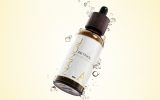In pursuit of beauty, many of us are not afraid to reach for new and unconventional substances – one of which is spirulina. What are the benefits of green algae for skin? Is it really worth implementing spirulina into your daily skin regimen?
Theoretically, we all know that algae have numerous health benefits. In practice just few know how to use them to make the most of their skin improving abilities. If you belong to the group of people willing to give green algae a try but you are not sure how to do it correctly – this how-to is for you. May the power of spirulina be with you!
A few words on spirulina
Spirulina is a microscopic green algae living in the warm lakes of Mexico and Africa. This information may be pretty surprising because most people associate algae with sea water only. When it comes to the name “spirulina” it derives from the algae structure – its shape resembles tiny spirals. Humans cannot see spirulina unless special magnifying tools are used. If it was not for the microscope, we would never learn that spirulina creates incredibly complicated structures. In Latin language, green algae appears either as Arthrospira platensis or Arthrospira maxima.
What makes spirulina so popular? The scientists confirm that green algae have rejuvenating properties, are antioxidative and increase metabolic rate in humans. No wonder why it is commonly used as a natural food supplement responsible for boosting the immune system and reducing the risk of coming down with various diseases.
Spirulina in skin care
Far more interesting, however, are the skin improving abilities of spirulina. This is a pretty newly discovered substance that scientists are constantly analyzing, mainly to learn all its properties in order to implement them later into the beauty industry. By far the scientists have proven that green algae is a rich source of proteins, making up 70% of its total mass. What else do we know about spirulina?
In spirulina you can find the following substances: amino acids, folic acid, B-group vitamins, vitamins A, C, D, E and K as well as precious minerals such as selenium, zinc, manganese, copper and iron. This is basically what makes green algae so good at nourishing and reviving the skin. Apart from that, the very constituents of spirulina make it a potent anti-inflammatory agent, it belongs to the antioxidant group and delays skin ageing. It can be said that spirulina does everything to help us feel and look better.
What is important, spirulina is also a source of EFAs (essential fatty acids) that many elements comprising our organism are made out of. For example, they are present in the human hair and make one of the skin’s hydro-lipid constituents. Finally, this inconspicuous micro-algae also offers omega-3 and omega-6 acids, which our hair and skin need to remain strong and healthy.
How does spirulina work?
- It combats bacteria responsible for causing acne.
- It is anti-inflammatory and relieves pain.
- This is a natural sunscreen that protects the skin from UV rays.
- It has an anti-ageing effect, which means that it helps skin stay younger for longer.
- It cleanses the skin and prevents blackheads.
- It reduces the risk of irritation (especially in over-reactive skin).
- It improves moisture levels in the skin, revives and makes skin stronger.
Spirulina face mask
Since spirulina is a precious algae, it is worth implementing it into your daily beauty routine. The easiest way to do it would be by creating a face mask. Below you will find a recipe for a green face mask that can give you marvelous effects.
You will need:
- powdered spirulina
- filtered water
- green clay (optional)
How to prepare it?
Take 2 spoons of powdered spirulina and combine it with 5 spoons of clean water. Stir until you obtain paste. If you want to, you can add green clay (1:1 or 3:1 in the case of over-reactive skin). On one hand, the consistency of your DIY green mask should be runny to facilitate application but on the other hand it cannot be too runny because otherwise it will run down your face.
How to use it?
Apply the mask to cleansed skin and let it sit for 15-20 minutes. If this is your first time with the spirulina face mask, you can remove it after 10 minutes. When it comes to the removal, this green face mask has to be taken off with lukewarm water. Follow with a face cream to keep all the nourishing substances delivered by the green algae inside the skin.



Leave a Reply